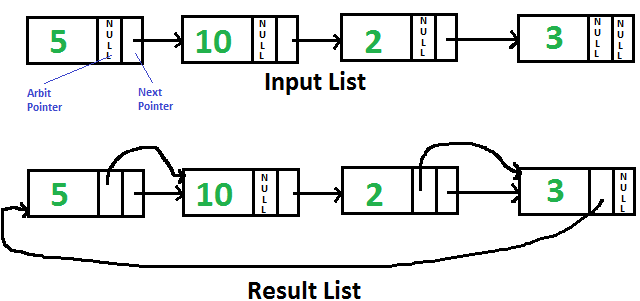Dada una lista enlazada individualmente con cada Node que tiene un puntero «arbitrario» adicional que actualmente apunta a NULL. Necesita hacer que el puntero «arbitrario» apunte al siguiente Node de mayor valor.

Recomendamos encarecidamente minimizar su navegador e intentarlo usted mismo primero.
Una solución simple es atravesar todos los Nodes uno por uno, para cada Node, encontrar el Node que tiene el siguiente valor mayor del Node actual y cambiar el puntero siguiente. La complejidad temporal de esta solución es O(n 2 ).
Una solución eficiente funciona en tiempo O(nLogn). La idea es usar Merge Sort para lista enlazada .
1) Atraviese la lista de entrada y copie el siguiente puntero en el puntero de arbitraje para cada Node.
2) Haga Merge Sort para la lista enlazada formada por punteros arbitrales.
A continuación se muestra la implementación de la idea anterior. Todas las funciones de clasificación de fusión se toman de aquí . Las funciones tomadas se modifican aquí para que funcionen en punteros de arbitraje en lugar de punteros siguientes.
C++
// Java program to populate arbit pointers
// to next higher value using merge sort
class LinkedList
{
static Node head;
// Link list node
static class Node
{
int data;
Node next, arbit;
Node(int data)
{
this.data = data;
next = null;
arbit = null;
}
}
// Utility function to print result
// linked list
void printList(Node node, Node anode)
{
System.out.println(
"Traversal using Next Pointer");
while (node != null)
{
System.out.print(node.data + " ");
node = node.next;
}
System.out.println(
"Traversal using Arbit Pointer");
while (anode != null)
{
System.out.print(
anode.data + " ");
anode = anode.arbit;
}
}
// This function populates arbit pointer
// in every node to the next higher value.
// And returns pointer to the node with
// minimum value
private Node populateArbit(Node start)
{
Node temp = start;
// Copy next pointers to arbit
// pointers
while (temp != null)
{
temp.arbit = temp.next;
temp = temp.next;
}
// Do merge sort for arbitrary pointers
// and return head of arbitrary pointer
// linked list
return MergeSort(start);
}
/* Sorts the linked list formed by
arbit pointers (does not change
next pointer or data) */
private Node MergeSort(Node start)
{
// Base case -- length
// 0 or 1
if (start == null ||
start.arbit == null)
{
return start;
}
/* Split head into 'middle' and
'nextofmiddle' sublists */
Node middle = getMiddle(start);
Node nextofmiddle = middle.arbit;
middle.arbit = null;
// Recursively sort the sublists
Node left = MergeSort(start);
Node right = MergeSort(nextofmiddle);
/* answer = merge the two sorted
lists together */
Node sortedlist = SortedMerge(left, right);
return sortedlist;
}
// Utility function to get the middle
// of the linked list
private Node getMiddle(Node source)
{
// Base case
if (source == null)
return source;
Node fastptr = source.arbit;
Node slowptr = source;
// Move fastptr by two and slow
// ptr by one. Finally slowptr
// will point to middle node
while (fastptr != null)
{
fastptr = fastptr.arbit;
if (fastptr != null)
{
slowptr = slowptr.arbit;
fastptr = fastptr.arbit;
}
}
return slowptr;
}
private Node SortedMerge(Node a,
Node b)
{
Node result = null;
// Base cases
if (a == null)
return b;
else if (b == null)
return a;
// Pick either a or b, and recur
if (a.data <= b.data)
{
result = a;
result.arbit =
SortedMerge(a.arbit, b);
}
else
{
result = b;
result.arbit = SortedMerge(a, b.arbit);
}
return result;
}
// Driver code
public static void main(String[] args)
{
LinkedList list = new LinkedList();
/* Let us create the list shown
above */
list.head = new Node(5);
list.head.next = new Node(10);
list.head.next.next = new Node(2);
list.head.next.next.next = new Node(3);
/* Sort the above created Linked List */
Node ahead = list.populateArbit(head);
System.out.println("Result Linked List is:");
list.printList(head, ahead);
}
}
// This code is contributed by shubham96301
Producción:
Result Linked List is: Traversal using Next Pointer 5, 10, 2, 3, Traversal using Arbit Pointer 2, 3, 5, 10,
Consulte el artículo completo sobre Apuntar al siguiente Node de mayor valor en una lista vinculada con un puntero arbitrario para obtener más detalles.
Publicación traducida automáticamente
Artículo escrito por GeeksforGeeks-1 y traducido por Barcelona Geeks. The original can be accessed here. Licence: CCBY-SA